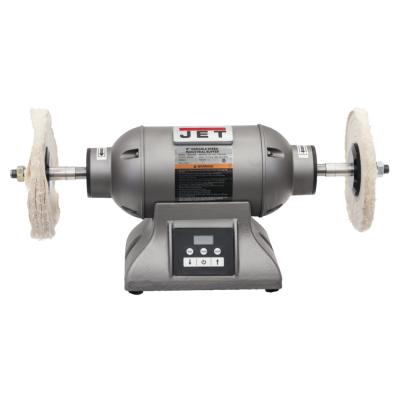
Manufacturing an industrial buffer to meet shop use demands was just what JET had in mind when it developed the new 8 in. industrial buffer. This 44 lb. benchtop buffer’s entire body is constructed of cast iron with a fully-enclosed industrial housing with factory-sealed, prelubricated ball-bearings for reliable, long life use. Rubber mounts at the buffer’s base help eliminate movement, plus dampen vibration.
This new JET buffer was designed with operator safety in mind, according to the company. The buffer’s motor includes brake resistors to shut down the wheels’ rotation so they come to a complete stop in less than 20 seconds.
Another big advantage of this industrial buffer is its variable-speed motor that operates from 900 to 3,600 rpm. Plus, there’s no on/off rocker switch. The power interface features an electronic touch pad panel with a power on/off control, flanked by up and down arrows to adjust and monitor the buffer’s speed.
The 1-hp buffer operates on prewired 115V current with a 230V option. The buffer has a standard 5/8 in. shaft with 8 x1/2 in. buffing wheels. It also incorporates spiral and half-spiral buffing wheels.
JET’s 8 in. Industrial Buffer has received CSA/US certification in meeting strict safety guidelines and electrical requirements.
Whether it’s buffing the high and low spots in metal or creating a mirror finish in aluminum, stainless steel, brass or copper, the JET buffer is up to the task.
Optional accessories include a Pedestal Stand (#578172), Gooseneck Lamp (#578100) and a Four Bar Buffing Compound Kit (577117).
The JET 8 in. industrial buffer (#578218, model no. IBG-8VSB) includes two buffer wheels.
Contact Details
Related Glossary Terms
- buffing
buffing
Use of rapidly spinning wires or fibers to effectively and economically remove burrs, scratches and similar mechanical imperfections from precision and highly stressed components. The greatest application is in the manufacture of gears and bearing races where the removal of sharp edges and stress risers by power methods has increased the speed of the operation.
